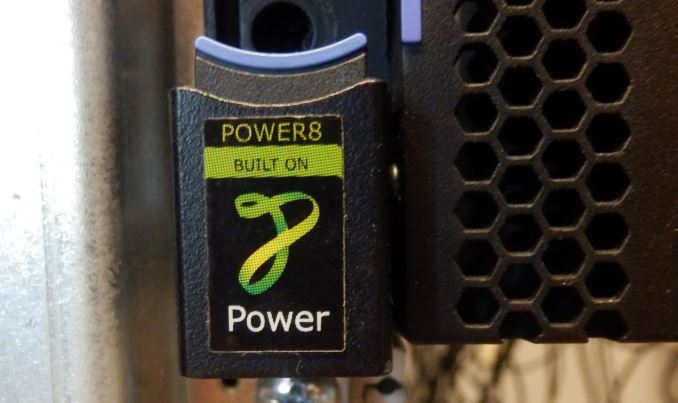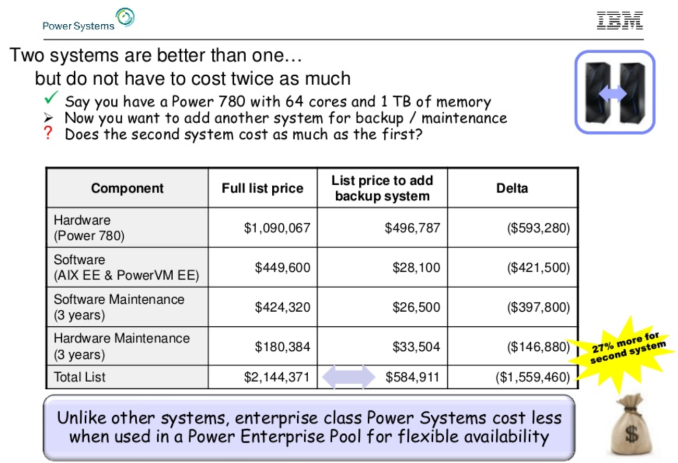The IBM POWER8 Review: Challenging the Intel Xeon
by Johan De Gelas on November 6, 2015 8:00 AM EST- Posted in
- IT Computing
- CPUs
- Enterprise
- Enterprise CPUs
- IBM
- POWER
- POWER8

Five years. That is how much time has passed since we have seen an affordable server processor that could keep up with or even beat Intel's best Xeons. These days no less than 95% of the server CPUs shipped are Intel Xeons. A few years ago, it looked like ARM servers were going to shake up the market this year, but to cut a long story short, it looks like the IBM POWER8 chip is probably the only viable alternative for the time being.
That was also noticeable in our Xeon E7 review, which was much more popular than we ever hoped. One of the reasons was the inclusion of a few IBM POWER8 benchmarks. We admit that the article was however incomplete: the POWER8 development machine we tested was a virtual machine with only 1 core, 8 threads and 2 GB of RAM, which is not enough to do any thorough server testing.
After seeing the reader interest in POWER8 in that previous article, we decided to investigate the matter further. To that end we met with Franz Bourlet, an enthusiastic technical sales engineer at IBM and he made sure we got access to an IBM S822L server. Thanks to Franz and the good people of Arrow Enterprise Computing Solutions, Arrow was able to lend us an IBM S822L server for our testing.
A Real Alternative?
Some of you may argue that the POWER based servers have been around for years now. But the slide below illustrates what we typically associated IBM's POWER range with:
Proudly, the IBM sales team states that you can save 1.5 million dollars after you have paid them 2 million dollars for your high-end 780 system. There is definitely a market for such hugely expensive and robust server systems as high end RISC machines are good for about 50,000 clients. But frankly for most of us, those systems are nothing more than an expensive curiosity.
Availability can be handled by software and most of us are looking/forced to reduce our capital expenses rather than increase them. We want fast, "reliable enough" servers at low costs that are easy to service. And that is exactly the reason why the single and dual sockets Xeon servers have been so popular the past decade. Can an IBM POWER server be a real alternative to the typical Xeon E5 server? The short but vague answer: a lot has changed in the past years and months. So yes, maybe.











146 Comments
View All Comments
JohanAnandtech - Wednesday, November 11, 2015 - link
I did not know you used 7500x3500, my testing was inspired on what the rest of the benchmarking community (Phoronix, Serverthehome) was using (obviously, 1024x768 is too small for current servers).http://www.anandtech.com/show/9567/the-power-8-rev...
This answers your question about threads, right?
JohanAnandtech - Wednesday, November 11, 2015 - link
Oh yes, changed the link. Thanks for the feedback!mapesdhs - Thursday, November 12, 2015 - link
Most welcome! And I really should move the more complex tests to the top of the page...Oh, my wording about threads was not what I'd intended. What I meant was, the no. of threads being larger than the supported no. of hardware threads. Thus, for a 12-core Power8 with 8 threads per core, try using 192 or 384 threads, instead of just the nominal 96 one might assume would make sense.
Ian.
MB13 - Wednesday, November 11, 2015 - link
POWER8 is full of innovation and brings change! An S812LC only costs $6,595 from IBM's external website! http://www-03.ibm.com/systems/power/hardware/s812l...The Power scale out boxes will save on your running and software costs as you can reduce your software licensing and server footprint.
With the OpenPOWER Foundation, you now have companies such as Tyan and Wistron who also create their own POWER8 servers and sell them independently of IBM. If you have not looked at The OpenPOWER Foundation and the innovation it brings through community and collaboration, your missing out big time!
There is change! Don't get left behind!
MB13 - Wednesday, November 11, 2015 - link
and don't forget - POWER8 runs Little Endian and support the latest versions of RedHat, SUSE and Ubuntu!The OpenPOWER servers are Linux only!
Gasaraki88 - Wednesday, November 11, 2015 - link
It's funny how this article is trying to "sell" me the system but I'm still not impressed. Costs more, less performance, and uses more power at idle and load than the Intel system.nils_ - Thursday, November 12, 2015 - link
What I found the most off putting is that you have to do a lot of work to get some things running with Linux. That's a big cost factor.nils_ - Thursday, November 12, 2015 - link
Having a lot of software that isn't really well ported is probably going to remain a problem for Power8 for years to come since so few people have access to these kinds of systems and the cost is prohibitive. The great thing with x86 and ARM is that you can use it at home/work pretty easily without shelling out a lot of money. On x86 you can be sure if your software builds locally and runs locally it will also run on your server.svj - Thursday, November 12, 2015 - link
Well written articles.1. I submit that the headline is misleading. Intel x86 does not compete with POWER at the high end. POWER L & LC line of servers are comparable to x86 based servers. IBM POWER is taking the battle to Intel's home turf.
2. The analysis leaves out cost of SW. Many organizations use commercial software which are priced per core. If POWER can do with 10 cores what Intel does with 18 cores, that means HUGE savings.
3. OPEN POWER is a huge move. I think the market will start seeing the results soon.
alpha754293 - Thursday, November 12, 2015 - link
An excellent review as always Johan. (haha...to zeeBomb. It is my understanding that Johan doesn't post probably as often as he might have otherwise like to because testing servers/enterprise computing solutions takes a LOT longer than testing/benching consumer-level systems. Some of the HPC applications that I run takes hours to days for each run, so when you're running it, you're running those tests over and over again, and before you know it, a month has gone by (or you've ran out of time with the system) or you have to purposely cut it short so that you can test a variety of software.)It's unfortunate that IBM never ported AIX to x86 (unlike Solaris.) I think that there would be more people trying to get into it if the cost of entry (even just to learn) isn't so high. I've looked at getting an old POWER4 system before for that purpose, but by then, the systems are so old and slow that it's like "what's the point?" I think that IBM is literally pricing themselves into extinction (along with their entire hardware/software ecosystem). Unfortunately for many businesses, AIX POWER servers still run their mainframe/backend which means that if you want to get paid $100k+ outta college - go learn AIX on POWER. As the current generation of sysadmins are starting to age and retire out, and they're going to have a hard time finding qualified people, the only way eventually would be that they would have to pay top dollar just to attract people into the field. (Unless they decide to move everything over to the x86/Xeon/Linux world. But for some mainframes (like financial institutions), that's DEFINITELY easier said than don).